Wallaby (ferry)
Wallaby was a ferry that operated on Sydney Harbour.
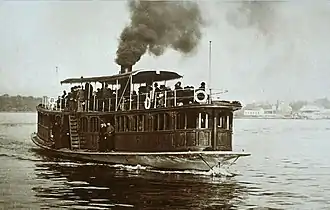 Wallaby in her original appearance | |
| History | |
|---|---|
| Name: | Wallaby |
| Operator: |
|
| Builder: | W. Dunn, Berry's Bay |
| Launched: | 1879 |
| Out of service: | 1918 |
| Fate: | broken up, 1926 |
| General characteristics | |
| Tonnage: | 163 tonnes |
| Length: | 33.1 m |
| Beam: | 5.6 m |
| Speed: | 10 knots |
| Capacity: | 305 |
Built in 1879 for the North Shore Ferry Company, she was Sydney's first double-ended screw ferry. This would become the standard model for almost all Sydney ferries until the late 20th century, a fleet that would become for a time the biggest in the world.
Wallaby was converted to a tug in 1918, and later to a lighter. She was broken up in 1926.
Service history
The North Shore Steam Ferry Company (Sydney Ferries Limited from 1900) began a regular scheduled ferry service from 1878 to Mosman as housing development in the area began to grow. Ferry transport was the only feasible way across the harbour at a time when roads were poor and there no bridge connection (the Sydney Harbour Bridge was opened in 1932).
Designed by civil engineer and naval architect, Norman Selfe, Wallaby was the world's second double-ended screw ferry. The North Shore Ferry Company's order for Wallaby was first, however, a Liverpool to Birkenhead ferry in England was the first double-ended screw ferry delivered into service. Wallaby was built by W. Dunn of Berrys Bay. Her 35 hp compound steam engine was built by Mort's Dock and Engineering and could push her to 10 knots. It is thought that she may have been meant to be called "Willoughby", and at the launch, the ship's sponsor mispronounced the name as "Wallaby".
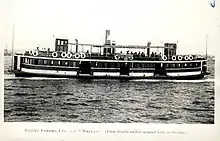
The 33.1 m long Wallaby could carry up to 305 passengers. She was the first Sydney ferry to have half-wheel and chains, a steering system used on Sydney ferry steamers for almost another fifty years. Enclosed wheelhouses were added later. Unusually, Wallaby's lower deck superstructure extended the full width of the hull to the inner sponsons. Thus, with no bulwarks there was no outside passenger area or seating on this level. It was the first ferry to have glazing across the whole lower deck. Previously, ferries had a glazed saloon only at one end for ladies, while the other end was only equipped with curtains which could be unrolled in bad weather. In choppy conditions, her low freeboard often allowed water to flow across the main deck.
Double-ended ferries did not need to turn around at the ports, making maneuvering easier and the transfer of cargo and passengers much faster. This was particularly useful at the increasingly busy main terminus of Circular Quay in Sydney Cove. Sydney already had a number double-ended paddle steamers, however, the double-ended screw ferry was a more difficult undertaking. Wallaby was not an immediate success, and the North Shore Steam Ferry Company continued to build paddle steamers through to 1885. However, over time, screw propulsion on double-ended ferries was perfected by designers such as Walter Reeks. The model became the norm for the fleet which became the largest during the booming early twentieth century before the opening of the Sydney Harbour Bridge.
Wallaby was converted to a tug in 1918, and later to a lighter. She was broken up in 1926.
Chronology
 Prior to addition of enclosed wheelhouses
Prior to addition of enclosed wheelhouses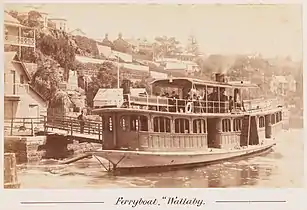 Likely to be berthing at Lavender Bay
Likely to be berthing at Lavender Bay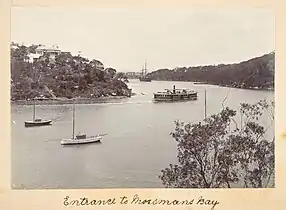 In Mosman Bay between 1879 to 1900
In Mosman Bay between 1879 to 1900
 Along side Kurraba (built 1899) at Circular Quay
Along side Kurraba (built 1899) at Circular Quay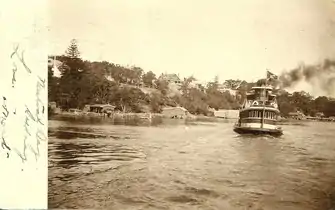 In Neutral Bay
In Neutral Bay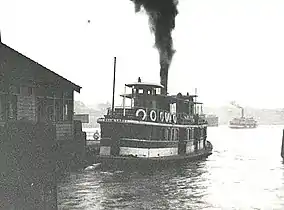 Leaving Circular Quay with enclosed wheelhouses
Leaving Circular Quay with enclosed wheelhouses
References
- Andrews, Graeme (1975). The Ferries of Sydney. A.H. & A.W. Reed Pty Ltd. ISBN 0589071726.
- Andrews, Graeme (1982). A Pictorial History of Ferries: Sydney and Surrounding Waterways. Sydney: AH & AW Reed Pty Ltd. ISBN 0589503863.
- Gunter, John (1978). Across the harbour : the story of Sydney's ferries. Rigby. ISBN 0727007157.
- Prescott, AM (1984). Sydney Ferry Fleet. Magill South Australia: Ronald H Parsons. ISBN 0909418306.
External links
 Media related to Wallaby (ship, 1879) at Wikimedia Commons
Media related to Wallaby (ship, 1879) at Wikimedia Commons